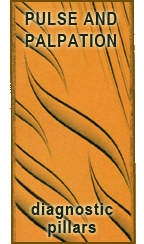Archive for the ‘Diagnosis’ Category
Symptomatic Diagnosis: Limbs & Extremities

The channels that pass through the extremities can be functionally regulated via the internal organs. This article describes the differentiation, treatment principles, and formulas of common health concerns associated with the limbs and extremities.
Edema of the extremities
Stiffness of the extremities
Flaccid paralysis of extremities “wei syndrome”
Varicose veins of the lower extremities
Feet pain
 Last modified: August 26, 2009 ·
Last modified: August 26, 2009 ·  al ·
al ·  No Comments
No Comments
 Tags: Channel, Diagnosis, Formulas, Herbs · Posted in: Symptomatic Diagnosis
Tags: Channel, Diagnosis, Formulas, Herbs · Posted in: Symptomatic Diagnosis
Symptomatic Diagnosis: Metabolic Disorders

Metabolic disorders are functional and systemic health issues for which Chinese medicine has many well-developed differentiations, treatment principles, and herbal formulas.
Obesity
Emaciation
Fatigue
 Last modified: August 26, 2009 ·
Last modified: August 26, 2009 ·  al ·
al ·  No Comments
No Comments
 Tags: Diagnosis, Formulas, Herbs · Posted in: Symptomatic Diagnosis
Tags: Diagnosis, Formulas, Herbs · Posted in: Symptomatic Diagnosis
Symptomatic Diagnosis: Chest & Back

The diagnostic “Ten Asking Song” pays particular attention to the chest and back. This article describes common complaints that arise from these areas, along with their differential diagnosis and herbal treatments.
Back Pain
Weakness of the lower back and knees
Chest Pain
Mass Formation in the abdomen
 Last modified: August 26, 2009 ·
Last modified: August 26, 2009 ·  al ·
al ·  No Comments
No Comments
 Tags: Diagnosis, Formulas, Herbs · Posted in: Symptomatic Diagnosis
Tags: Diagnosis, Formulas, Herbs · Posted in: Symptomatic Diagnosis
The Educational Benefits of Pulse Quality Mechanisms

Early on in my own CM training, I began to recognize the value of getting very clear on underlying theories and mechanisms. As a practitioner, understanding mechanisms allows you much more flexibility in the use of herbal medicines as well.
 Last modified: August 26, 2009 ·
Last modified: August 26, 2009 ·  al ·
al ·  No Comments
No Comments
 Tags: Acupuncture, Diagnosis, Herbs · Posted in: Pulse Class, Pulse-Palpation
Tags: Acupuncture, Diagnosis, Herbs · Posted in: Pulse Class, Pulse-Palpation
Pulse Education and Translation Problems

One of the more frustrating problems Chinese medicine folks have in the English speaking world is getting past translations of pulse terms to arrive at less ambiguous descriptions of these different pulses.
 Last modified: August 25, 2009 ·
Last modified: August 25, 2009 ·  al ·
al ·  No Comments
No Comments
 Tags: Diagnosis, Palpation · Posted in: Pulse Class, Pulse-Palpation
Tags: Diagnosis, Palpation · Posted in: Pulse Class, Pulse-Palpation
The Normal Pulse

The Normal Pulse The normal pulse is defined as: neither deep nor superficial, wide nor thin, forceful nor forceless, with a regular rhythm, between 60-90 beats per minute.
 Last modified: August 24, 2009 ·
Last modified: August 24, 2009 ·  al ·
al ·  No Comments
No Comments
 Tags: Diagnosis, Practitioners · Posted in: Pulse Class, Pulse-Palpation
Tags: Diagnosis, Practitioners · Posted in: Pulse Class, Pulse-Palpation
Simple Pulse Qualities

These first six pairs of ridiculously simple pulse measurements don’t rely on intuition, self-cultivation, or psychic abilities.
 Last modified: August 23, 2009 ·
Last modified: August 23, 2009 ·  al ·
al ·  No Comments
No Comments
 Tags: Diagnosis, Palpation · Posted in: Pulse Class, Pulse-Palpation
Tags: Diagnosis, Palpation · Posted in: Pulse Class, Pulse-Palpation
Simple Pulse Qualities: Depth

Depth: deep-superficial The deep pulse is associated with either a deficiency of yang qi to lift the pulse upward, or an obstruction to the yang qi that prevents it from rising systemically and lifting the pulse.
 Last modified: August 22, 2009 ·
Last modified: August 22, 2009 ·  al ·
al ·  No Comments
No Comments
 Tags: Diagnosis, Palpation · Posted in: Pulse Class, Pulse-Palpation
Tags: Diagnosis, Palpation · Posted in: Pulse Class, Pulse-Palpation
Simple Pulse Qualities: Rate

The slow pulse is due to a deficiency of pulse power as manifest in its rate rather than strength.
 Last modified: August 21, 2009 ·
Last modified: August 21, 2009 ·  al ·
al ·  No Comments
No Comments
 Tags: Diagnosis, Palpation · Posted in: Pulse Class, Pulse-Palpation
Tags: Diagnosis, Palpation · Posted in: Pulse Class, Pulse-Palpation
Simple Pulse Qualities: Rhythm

Rhythm: rhythmic-arrhythmic Again, this comes down to the Heart’s yang (or qi in the absence of cold symptoms) from flowing smoothly.
 Last modified: August 20, 2009 ·
Last modified: August 20, 2009 ·  al ·
al ·  No Comments
No Comments
 Tags: Diagnosis, Palpation · Posted in: Pulse Class, Pulse-Palpation
Tags: Diagnosis, Palpation · Posted in: Pulse Class, Pulse-Palpation
